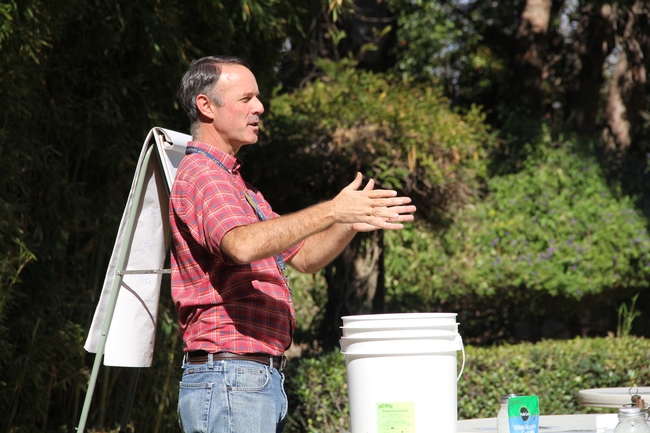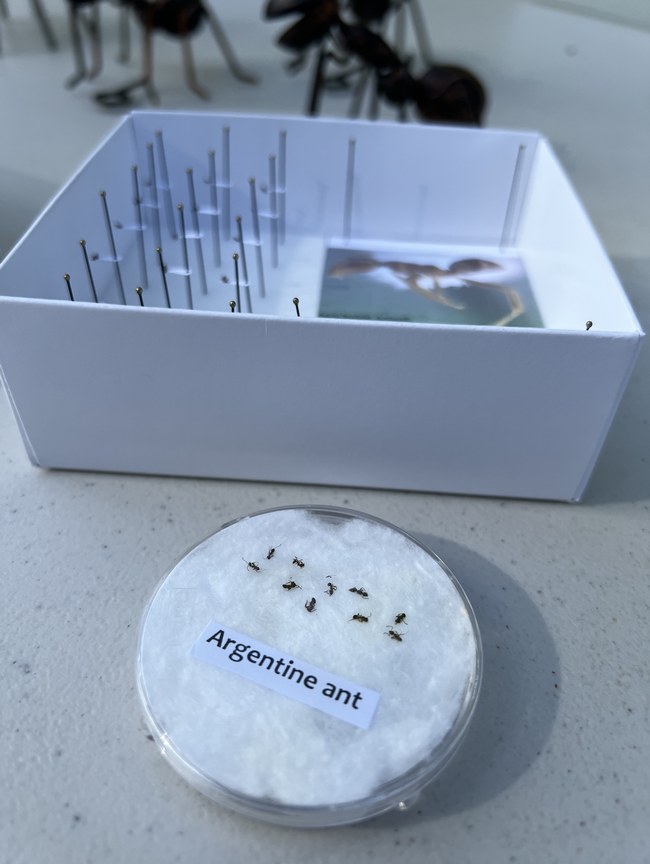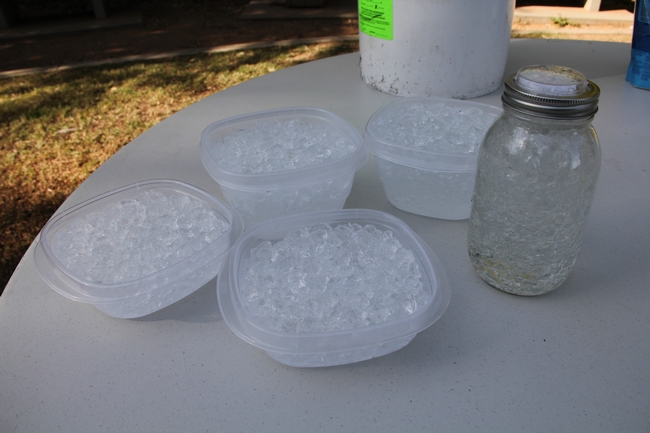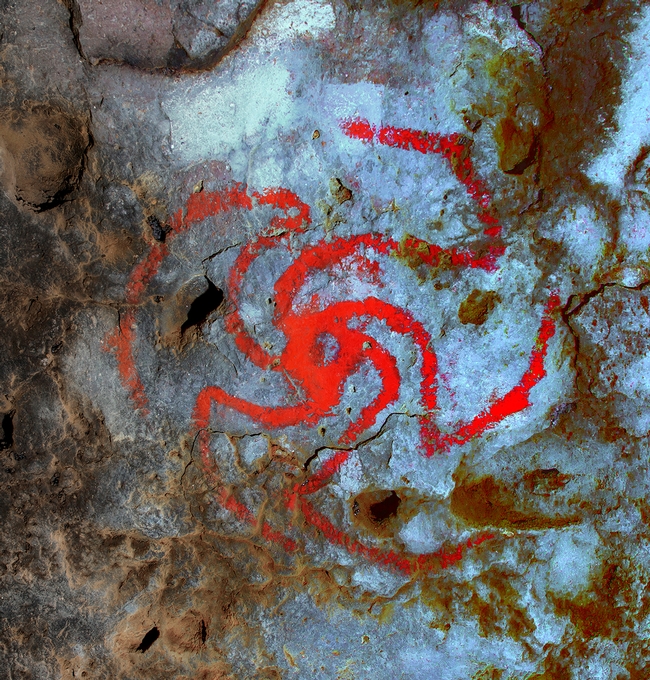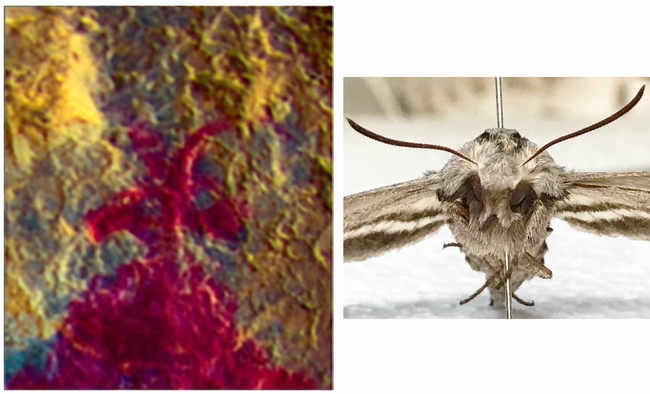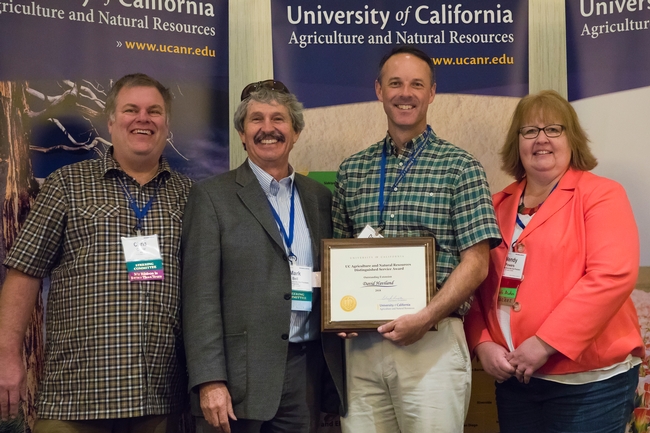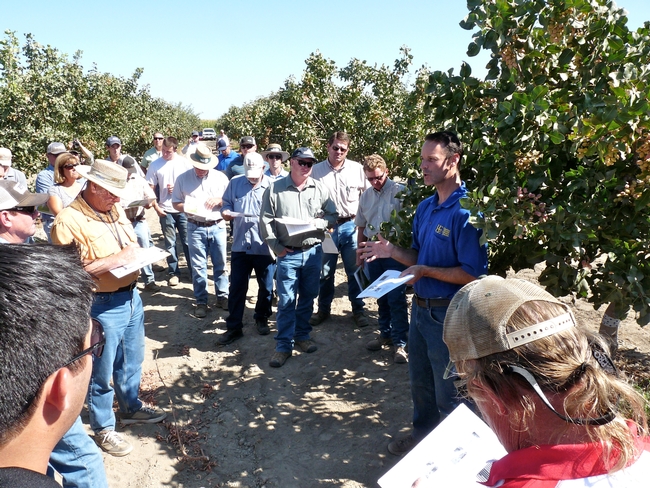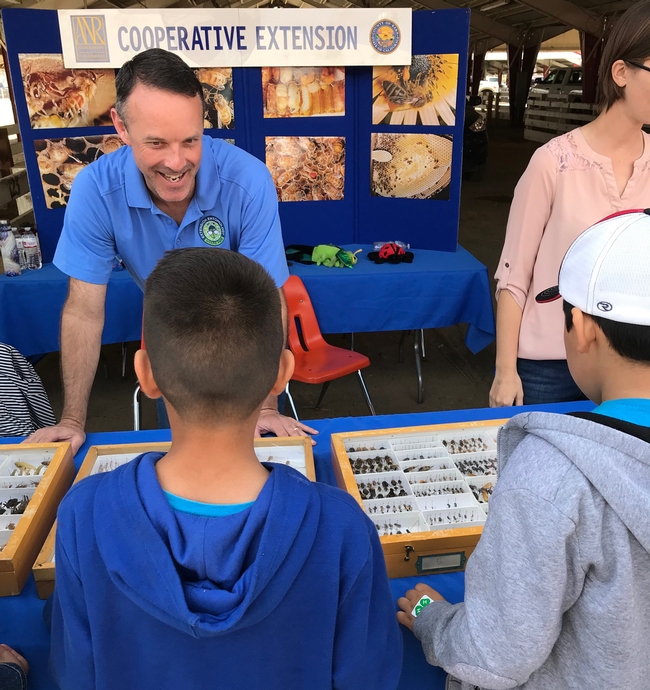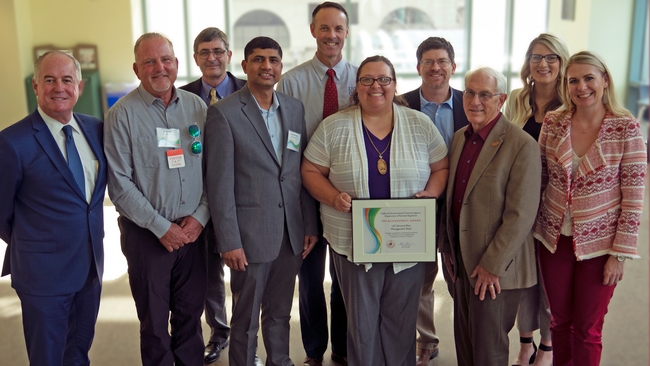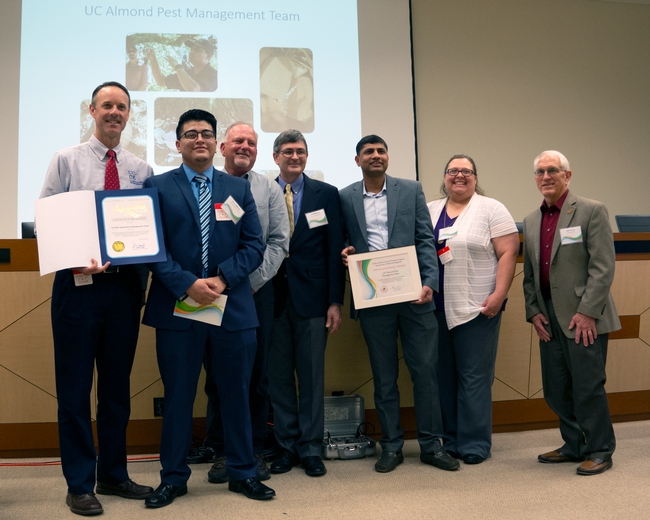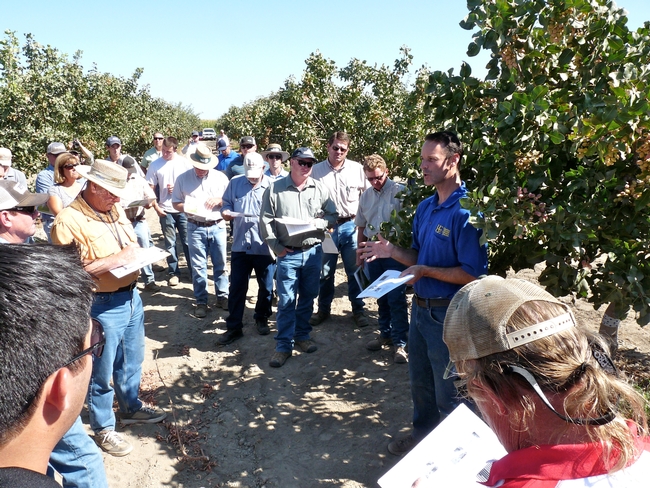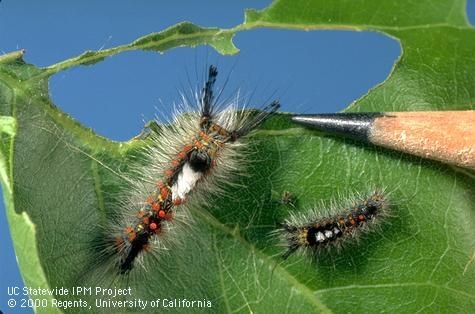Posts Tagged: Haviland
UCCE researchers target sugar-feeding ants, a key to controlling citrus pests, disease
Sugar-feeding ants protect pests that infect trees and damage the fruit they bear. Insecticides are often a go-to solution, but may kill beneficial insects in the process, too. Thankfully, Mark Hoddle, University of California Cooperative Extension entomologist and biological control specialist at UC Riverside, together with UCR colleagues in chemical engineering, developed a biodegradable hydrogel baiting system that targets ant populations, which protect sap-sucking pests from their natural enemies. Control of ants allows beneficial parasitoids and predators to greatly reduce pest populations.
Deciding to expand Hoddle's research was a “no-brainer” according to David Haviland, UC Cooperative Extension farm advisor in Kern County.
Haviland is investigating active ingredients that can be effectively used in hydrogel baiting systems. His research builds on Hoddle's use of alginate gels, also known as water beads, soaked in sugar water to control Argentine ants.
“What we're doing in California can benefit places like Florida, Texas, Mexico and beyond,” Haviland said.
The Hoddle lab conducted two years of orchard research showing that when ants are controlled, the amount of citrus flush infested with Asian citrus psyllid (ACP), a mottled brown insect that vectors the pathogen causing citrus greening, decreases by 75%. Citrus flush refers to newly developed leaves.
“But benefits are not restricted to just ACP with Argentine ant control, as natural enemies destroy colonies of other sap-sucking pests too,” said Hoddle. “For example, citrus mealybug infestations on leaves were completely eliminated by natural enemies, 100% control, while densities of fruit infested by mealybugs were reduced by 50%.”
The Hoddle lab's success inspired Haviland to consider how this approach will fare in different regions of the state where there are different crops, different pests and different ant species.
Haviland has worked for many years on solid baits that are effective and affordable for ants that feed primarily on protein, like fire ants in almonds, but successful control measures for sugar-feeding ants that drink their food have been elusive.
“Therefore, we're using hydrogels to essentially turn a liquid bait into a solid, making it effective and commercially adoptable,” Haviland said. He and his team are assessing whether active ingredients that undoubtedly work against ants, like thiamethoxam, maintain their effects in a hydrogel system.
Unlike Hoddle's biodegradable alginate gels, Haviland is relying on acrylamide gels that are similar to the absorbing material you would find in a diaper. These gels are not organic, but are currently accessible on a commercial scale, and have been shown to be effective in wine grapes on the North Coast by a Cooperative Extension advisor in Napa County, Monica Cooper. Haviland's current research efforts are focused on citrus, table grapes and wine grapes in the San Joaquin Valley, and on lemons on the coast.
The primary challenge now is navigating pesticide regulations and registration.
“This is cutting-edge research,” Haviland said, and manufacturer labels for the products being used need to be updated to include hydrogels as an approved use. This process takes time. Additionally, adding new product uses needs to make economic sense for the manufacturer.
Hoddle and Haviland's research can provide data for adding these methods to the product labels.
“If we can show that this tech works against lots of pests, lots of ant species, in lots of different crops across California, hopefully we'll achieve a critical mass of benefits that motivates product manufacturers to make modifications to their labels,” said Haviland.
Haviland is hopeful about the process, and said he believes that UC ANR is in a prime position to lead innovation for an issue that requires collaboration among specialists, advisors and the industry.
Ancient Native Americans painted a common psychoactive weed in Kern County rock art
An international team of researchers has established a connection between ancient Indian rock art painted in a Kern County cave and a common California plant that was used by Native Americans in their sacred rituals.
This is the first time a hallucinogen has been tied to rock art, the researchers said in their article published in the November 2020 Proceedings of the National Academy of Sciences.
UC Cooperative Extension advisor David Haviland, a Kern County entomology expert, was able to work with the researchers to confirm the notion that one of the images painted on the Pinwheel Cave in Wild Wolves Preserve is likely a sphinx moth, an insect that pollinates Datura. Datura is a genus of plants native to North America that include the common agricultural pest jimson weed (Datura stramonium) and sacred thornapple (Datura wrightii).
“I've experienced hundreds of sphinx moths pollinating Datura,” Haviland said. “The sun starts to go down, the large white flowers open up and attract the moths. Scientists have reported that, after drinking the nectar with their long proboscises, they fly a little erratically, suggesting that, even to the moths, the nectar has a small narcotic effect.”
An image in the cave appears to show a human figure with a sphinx moth head. In another part of the cave, Native Americans painted a bright red pinwheel shape, which the scientists believe depicts a Datura flower as it swirls open. The most telling evidence that connects the Datura to the cave art is dozens of masticated wads of Datura plant fiber that were found pressed into crevices inside the cave.
“This indicates that Datura was ingested in the cave and that the rock painting represents the plant itself, serving to codify communal rituals involving this powerful entheogen,” wrote the researchers in their PNAS article.
Datura is known to have been used by Native American youth when initiated into adulthood, where the root was processed into a tea known historically as toloache. Datura could also be taken throughout their lives to invoke supernatural power for doctoring, counteract negative supernatural events, ward off ghosts or see the future.
Today, Native Americans' descendants recognize the plant's toxicity and no longer ingest Datura, while still respecting their ancestors' knowledge in using a substance that was dangerous and could result in death if the dosage were miscalculated.
“The authors of the article agree: the plant can be highly toxic and should never be consumed,” said David Robinson, United Kingdom archaeologist and the research leader.
Robinson and his team noticed the clumps of fiber, or quids, tucked into crevices on the wall when they were researching Pinwheel Cave in 2007. Quids are commonly found where Native Americans have chewed vegetation to extract nutrition. The scientists analyzed the quids for ancient DNA evidence, but found none. They did discover the wads of vegetation were not comprised of a typical Native dietary staples.
The scientists used three-dimensional digital microscopy on 15 clumps found in the cave, and identified evidence that the Native Americans' chewed and bit the quids with their teeth to extract atropine and scopolamine – two hallucinogenic alkaloids found in Datura. Almost all the samples are Datura wrightii. One exception was a quid of Yucca.
Fifty-six clearly identifiable quids were found in the Pinwheel Cave crevices, but traces of fibrous materials in crevices indicate there were many more in the past that are now gone. Based on radiocarbon dating, the oldest quid studied contained 400-year-old plant material; the newest one was from 130 years ago.
With the scientific analysis of the quids, the researchers were able to interpret the ancient rock art images.
“Rather than the art depicting what is seen in a trance, the pinwheel is likely a representation of the plant causing the trance,” the article says. “The rock art thus established the space where individuals underwent a deeply meaningful first-hand entheogenic experience within the context of an important communal site.”
Entomologist’s work benefits Kern County agriculture
This is the fourth in a series featuring a few scientists whose work exemplifies UC ANR's public value for California.
UC Cooperative Extension entomology advisor David Haviland has been recognized by his peers, his clientele, and extension directors who oversee programs in 14 western U.S. states. It's a Cooperative Extension hat trick unusual among UCCE mid-career professionals.
“The combination of three awards for me is an incredible honor because I know there are a lot of good extension programs out there,” Haviland said.
In July 2019, Haviland accepted an Award of Excellence from the Western Extension Directors Association (WEDA) on behalf of a team of scientists and commodity representatives. In 2018, he received a Distinguished Service Award for Excellence in Extension from UC Agriculture and Natural Resources, UCCE's parent organization, and the Pacific Branch Entomological Society of America honored him with an award for Excellence in Extension.
In addition, Haviland just completed a two-year term as president of the Association of Applied IPM Ecologists.“This is a professional society for growers and pest control advisers who are advocates of integrated pest management,” Haviland said. “I was elected president of an association of my clientele, the people I'm here to serve.”
While Haviland is providing pest management solutions for farmers, he is also adding to UC Cooperative Extension's value to the community of Kern County and California. For example, after two years of research and extension in almond pest management, pest control advisors who participated in one or more of Haviland's activities reported a 25% increase in using a new ‘green' technology called mating disruption for navel orangeworm control. Mating disruption reduces pesticide use, helping to safeguard an abundant and healthy food supply.
When spotted wing drosophila invaded the southern San Joaquin Valley, cherry growers lost tens of millions of dollars. Haviland responded by developing field data on pest phenology, chemical controls, and the effects of pesticide degradation of the efficacy of control programs. He combined this information into guidelines that he taught to cherry growers. Using these guidelines saves cherry growers in Kern County millions of dollars in averted losses annually, promoting more economic prosperity in the region.
Haviland devoted his career to UCCE. After a two-year mission in Buenos Aires, where he learned to speak Spanish fluently, and a bachelor's degree in zoology at Brigham Young University, the Salinas native joined UC Cooperative Extension as an agricultural assistant at the Monterey County office in 1997. There he worked with academics in entomology, plant pathology, weed science, soil science and viticulture.
“Before that job, I wasn't clear what UCCE was,” he said. “I was shocked that there was such a thing as a career that allowed you to study insects, work in agriculture, do research, teach and get paid for it. All those things fascinated me and were part of my skill set.”
Knowing that a farm advisor position requires a master's degree, he moved with his family to Davis, where he undertook coursework in plant protection and pest management. During his last semester, a unique position at UC Cooperative Extension became available. Haviland applied and was offered the position as the Kern County entomology advisor affiliated with the UC Statewide Integrated Pest Management Program. He began work in Bakersfield the day after his master's thesis was signed in July 2002.
“I was really excited for the job,” Haviland said. “I was excited to be a farm advisor in a big agricultural county. And also, the Statewide IPM Program gave me a peer group in entomology to help me early in my career. That was invaluable.”
The 2019 WEDA award recognized teams that were assembled over 15 years to help Kern County growers respond to invasive pests that were threatening California agriculture. Teams were created to address a variety of pests, each requiring a different expertise.
“For spotted wing drosophila in cherries, we needed entomologists and a pomologist. For sharpshooters in grapes, mealybugs in pistachios and navel orangeworm in almonds we responded using teams of commodity advisors, IPM advisors, UC specialists and industry stakeholders, including commodity boards,” Haviland said. “We also formed a team to train farm labor contractors about pesticide drift so they could train fieldworkers on how to be safe at work.”
Haviland is also active in the Almond Pest Management Alliance Team, which received the 2019 California Department of Pesticide Regulation (CDPR) Integrated Pest Management Achievement Award. For more than a decade, the team conducted research on navel orangeworm, spider mites, leaffooted bug and ants that laid the groundwork for IPM adoption. For the past three years, they put these IPM practices on display using eight demonstration orchards across the San Joaquin Valley as part of a CDPR Pest Management Alliance Grant.
In teaching farm labor contractors, and in other capacities throughout his career, Haviland said his Spanish fluency has been an excellent tool.
“People who work in the agricultural industry are most likely to find Spanish-speaking field workers,” he said. “Instead of training supervisors in English, and having them translate materials, we are training workers in their own language so they can be as proficient as possible.”
Now that he is in the second half of his career, Haviland said he is serving as a mentor to new advisors, providing knowledge and support that were so important to him when he was first hired.
“I had some fabulous mentors who did everything in their power to give me a quick start to my career,” he said. “Now it's time to do my part.”
For the past two years, Haviland has worked with young entomology advisors by creating a pest management alliance project that secured funding for large-scale regional almond projects across the Central Valley. These types of projects provide funding and support that can launch new advisors into successful careers.
UCCE scientists are part of a new work group to find alternatives to chlorpyrifos
The California Department of Pesticide Regulation has formed a work group to find alternatives to the pesticide chlorpyrifos that will help farmers manage insect pests when a state ban on the chemical goes into effect, reported Kerry Klein on Valley Public Radio.
Klein interviewed David Haviland, UC Cooperative Extension entomology advisor and a member of the work group.
“This is an important topic,” Haviland said. “Chlorpyrifos has had a lot of benefits to agriculture for many years. At the same time, it does have some negative issues associated with it that were the reason that the product has been proposed to be discontinued.”
Chlorpyrifos is a common insecticide used under the trade names Lorsban, Lock-on and generic formulations to control ants, stink bugs, aphids, whiteflies and other pests. UC IPM coordinated a comprehensive report on chlorpyrifos in 2014, commissioned by DPR, outlining critical uses of the pesticide in alfalfa, almonds, citrus and cotton. The report details the insecticide's use patterns as compared to other pest control tactics, such as resistant varieties, mating disruption, field sanitation and other insecticides.
The new work group will develop short-term and five-year action plans to identify safer, more sustainable pest management tools, practices, and alternatives in a wide array of crops. They will seek solutions that are safe for workers, communities and the environment, able to adequately control targeted pests, and cost effective. In addition, the work group will consider the issues of efficacy, soil health and climate change.
The solutions might include combinations of other pesticides to help protect the dozens of crops on which chlorpyrifos is used. Haviland says the group will prioritize the most urgent needs first: “Who's really going to take a hit from the ban, and from there, what is the best way to go forward,” he said.
Along with Haviland, UC Agriculture and Natural Resources is represented on the new work group by UC IPM advisor emeritus Pete Goodell and UCCE field crops advisor Michael Rethwisch.
ANR in the news April 19-30
CDFA awards grant for Proactive IPM program
(Morning Ag Clips) April 30
The California Department of Food and Agriculture has awarded funding for one project in the initial funding cycle for the Proactive Integrated Pest Management (IPM) Solutions grant program. The project, titled “Proactive Biological Control of Spotted Lantern Fly, Lycorma delicatula (Hemiptera: Fulgoridae)” was awarded $543,936.
The three-year project will develop biological control agents for spotted lantern fly, an invasive pest that has not yet arrived in California but is spreading rapidly across the eastern US. This pest has the potential to affect many high-value California crops including grapes, walnuts, avocados, and pistachios. The project will piggyback on work that is already being conducted on the pest in the eastern US and abroad. Project leads are Dr. Mark Hoddle (UC Riverside) and Dr. Kent Daane (UC Berkeley). The biological control agent is a small (3 mm) stingless wasp, native to China, that parasitizes the eggs of the spotted lantern fly.
https://www.morningagclips.com/cdfa-awards-grant-for-proactive-ipm-program
Learn about sheep, shearing, and more at Barn to Yarn in Hopland this week
(MendoVoice) April 30
If you've ever wondered how a sheep's wool becomes a sweater, you might want to check out the "Barn to Yarn" event in Hopland this weekend. This popular springtime event will return to the University of California Hopland Research and Extension Center this Saturday, May 4.
The Barn to Yarn event will feature farmers and ranches, shearers, spinners, weavers, and knitters, and other local experts involved in the Northern California sheep industry. There will educational activities, presentations, workshops, take-home craft activities, and more for all ages.
Moth caterpillars are back for a rare second bite in the Bay Area
(Mercury News) Cat Ferguson, April 29
…Andrew Sutherland, University of California Cooperative Extension's urban integrated pest management adviser for the Bay Area, recommends a simple preventive measure: reach for the hose.
Right after the bugs have hatched, “use pressure washers to push the larvae off the trees before they start wandering around,” he said. “In the late summer and fall, if you've got egg masses, you can wash them off and you won't have an issue next year on that tree.”
Bay Area pest control and horticulture experts say most caterpillar calls come from Santa Clara and southern San Mateo counties, which Sutherland linked to warm weather and high densities of host plants — the caterpillars are particularly fond of oak and fruit trees. Sutherland said he doesn't field nearly as many calls from the East Bay.
https://www.mercurynews.com/2019/04/29/san-jose-moth-boom/
Hopland Research Center holds BioBlitz for Mendocino County students
(Ukiah Daily Journal) Curtis Driscoll, April 26
The Hopland Research and Extension Center held its annual “BioBlitz” on Friday for over 200 students from across Mendocino County, giving them a chance to explore their interest in science by finding new species at the Hopland Research Site.
The BioBlitz went on at the same time as the 2019 City Nature Challenge, an international event where people find and document plants and wildlife in cities across the globe. Although students in Mendocino County couldn't participate in the national event, the Hopland Research Center decided to have the BioBlitz as a way to allow students to explore nature in Mendocino County.
…Experts also helped the students learn more about the area in Mendocino County and the many kinds of unique species that are in the county. Anna Holmquist, an arachnologist from UC Berkeley, entomology students from UC Berkeley, and California Naturalists, people who have gone through a UC naturalist training program, were all available throughout the day to help students and guide them as they made different discoveries.
“We will be looking for species with them and searching and trying to add to the list, but there will be a bit more depth to it with the kids actually trying to build on their understand of our Mendocino habitats,” said Hopland Research Center Community Educator Hannah Bird.
Have the Tough Conversations: Koopmann Family Ranch Transfer
(Capital Press) Ashley Rood, April 26
… The next generation of Koopmanns, Carissa and Clayton, are well-poised to continue the family legacy of conservation and ranching. Both are building up their own cow herds on leased land while, as partners in the family LCC, they help make the big decisions. They also have full-time agriculture jobs off the ranch focused on grazing. Clayton is the range manager for the local water utility, the SFPUC, and has a grazing management consulting business. Carissa is a livestock and natural resources advisor for University of California Cooperative Extension in Siskiyou County. Both Carissa and Clayton emphasize how hard it is to make a living ranching alone, even with all the advantages of the family ranch. But getting out on the land, despite the hard work, is a place of relaxation for both of them.
For others considering succession planning, Carissa says, “Get started early and don't ever make assumptions. It's vital to know what everybody truly wants. Ultimately, the end goal that is that you're still a family, regardless of what happens.”
Fresh, local and sustainable advice
(Marin Independent Journal) Jane Scurich, April 26
Ah, spring! Time to visit the local farmers market for tender locally grown asparagus, luscious spring peas and great gardening advice. Wait — what's that last item — advice? Yes — and it's free!
Knowledgeable, UC-trained volunteers in the University of California Marin Master Gardener program officially open their market advice tables in May to provide research-based information on horticulture and sustainable gardening practices to Marin residents.
https://www.marinij.com/2019/04/26/fresh-local-and-sustainable-advice/
Love science? Free app allows you to assist in research!
(ABC10) Monica Woods, April 25
…In the words of Laci Gerhart-Barley, iNaturalist is "Instagram for biology and nature enthusiasts." The professor with the biological services department at the University of California, Davis, is even incorporating it into her classroom.
… Each year iNaturalist users participate in a "competition" to see what region can upload the most photos in the matter of a few days. The City Nature Challenge started as a competition between the California Academy of Sciences in San Francisco and the Los Angeles County Natural History Museum and gradually grew to include regions all over the world.
The Sacramento region is getting on board for the first time in 2019. [Sarah Angulo, community education specialist for the California Naturalist Program, is helping organize the challenge.]
The City Nature Challenge Sacramento will take place from Friday, April 26 to Monday, April 29.
UC Extension head updates supervisors on programs and leaders
(Plumas News) Victoria Metcalf, April 24
The face of the Farm Advisor's office is changing.
Plumas and Sierra county Farm Advisor Director David Lile was before the Plumas County Board of Supervisors April 9, explaining just how much his staff has changed.
… Holding up a copy of the local University of California Agriculture and Natural Resources annual report for last year, Lile said, It's “easy to look at with plenty of pictures.”
…Lile then introduced Ryan Tompkins as the new forestry advisor. He replaces longtime representative Mike DeLasaux who retired in 2018.
…Natural resources and livestock liaison with local ranchers was introduced next. That's Tracy Scholr [Schohr].
…Most 4-H members and their parents already know 4-H Program Representative Kari O'Reilly.
… Tom Getts was also introduced as the technical assistance for Plumas and Sierra farmers and Susanville area land managers.
… And Barbara Goulet, as administrative assistant, provides support to the staff, but also works with local Master Gardener volunteers and 4-H volunteers, according to Lile.
http://www.plumasnews.com/uc-extension-head-updates-supervisors-on-programs-and-leaders/
Can California get cows to burp less methane?
(NBC News) April 24
California is now requiring the beef and dairy industry to reduce its greenhouse gas emissions. Some scientists are testing and growing a red algae seaweed that can reduce methane from cow burps.
https://www.nbcnews.com/leftfield/video/can-california-get-cows-to-burp-less-methane-1506967107599
How to Control Thrips in Blueberries
(California Fresh Fruit) Matthew Malcolm, April 24
Citrus thrips have been a major nuisance for California blueberry growers, but how do you keep them under control and when should you apply crop protection materials? Is there an organic treatment available? Watch this brief interview UC Cooperative Extension Farm Advisor David Haviland as he answers all these questions. Read more about blueberry pest management in California Fresh Fruit Magazine.
https://calfreshfruit.com/2019/04/24/how-to-control-thrips-in-blueberries/
UC: Older vineyards can be modified for mechanization
(Ag Alert) April 24
Saying they have proven that older vineyards can be converted to mechanization, University of California Cooperative Extension specialists say winegrape growers in the San Joaquin Valley do not have to replant vineyards if they want to switch to mechanical pruning.
Growers who want to make the switch can retrain the vines to make the transition, without losing fruit yield or quality, according to a UCCE study.
UCCE specialist Kaan Kurtural said the study found that "growers do not have to plant a new vineyard to mechanize their operations."
"We have proven beyond a doubt that an older vineyard can be converted to mechanization," he said.
There is no loss in yield during conversion, Kurtural said, "and post-conversion yield is better and fruit quality is equivalent to or better than hand-managed vines."
http://agalert.com/story/?id=12932
No replanting needed for mechanical pruning
(Farm Press) Tim Hearden, April 24
University of California (UC) researcher Kaan Kurtural has gained recognition in recent years for automating a vineyard operation in the Napa Valley, which was planted at a density conducive to the practice.
Now Kurtural and other UC Cooperative Extension scientists are applying their knowledge in the San Joaquin Valley, where they say growers who wish to switch from hand to mechanical pruning to save labor won't have to replant to do so.
https://www.farmprogress.com/grapes/no-replanting-needed-mechanical-pruning
Wet winter in Sonoma County may have helped spread virulent oak disease
(Press Democrat) Derek Moore, April 24
Now that the North Coast is finally drying out from an unusually wet winter, concern is growing over the potential rapid spread of sudden oak disease, renewing calls for the public's help tracking the deadly forest pathogen.
“Now is when we might expect the pathogen to take off a bit,” said Kerry Wininger, a UC Cooperative Extension staffer in Santa Rosa.
Wininger is a local organizer of annual sudden oak death surveys known as the SOD Blitz. This year's survey occurs from April 25 to 28 across Sonoma and Mendocino counties. Organizers are hoping for a good turnout of volunteers, who will become educated spotters and collectors to help scientists slow the disease's spread.
https://www.sonomanews.com/lifestyle/9531662-181/wet-winter-in-sonoma-county
Young chefs: Local students prepare and taste international meals at fourth annual Culinary Academy
(Lompoc Record) Lorenzo J. Reyna, April 24
Twenty-one elementary school students spent part of their spring break learning to cook various international recipes inside Rice Elementary School's cafeteria Wednesday.
The fifth- and sixth-graders from 4-H Student Nutrition Advisory Council Clubs took part in the fourth annual Culinary Academy, spearheaded by six adults from UC CalFresh Healthy Living.
…Janelle Hansen helps oversee the 4-H SNAC Clubs as supervisor of the Santa Barbara and San Luis Obispo group.
She said Wednesday's five-hour event from 1 to 6 p.m. was much more than just students learning how to create various dishes.
“The hope is that they will learn the life skill of healthy living and nutrition — and that's really one of our goals,” Hansen said as the students were preparing their meals.
Close to home or farther afield, visit California's native plants and gardens
(Los Altos Online) Tanya Kucak, April 24
If you're in the mood for some road trips, immerse yourself in an atmosphere of beautiful plants and enthusiastic people by attending the Going Native Garden Tour, now in its 17th year.
Sponsored by the California Native Plant Society in association with the UC Cooperative Extension Master Gardeners of Santa Clara County, the tour offers an unparalleled chance to talk with gardeners and designers, view gardens of different types and compare gardens planted a year ago to those planted a couple of decades ago. More than 50 gardens are scheduled to be open 10 a.m. to 4 p.m. May 4 and 5. Gardens in San Jose and other southern Santa Clara County cities will be open May 4, while May 5 will feature visits to northern gardens from San Mateo to Sunnyvale, including Mountain View. No Los Altos gardens will be on display this year.
https://www.losaltosonline.com/news/sections/magazine/59930-
AgriTalk: How Agriculture is Managing High-Level Issues
(Agweb.com) Ashley Davenport, April 23
Dr. Frank Mitloehner of the University of California-Davis recently was awarded the 2019 Borlaug Council for Agricultural Science and Technology (CAST) award. He talks about what that award means for him, how he started on social media, and greenhouse gas emissions.
https://www.agweb.com/mobile/article/agritalk-how-agriculture-is-managing-high-level-issues/
Mechanical Vineyard Pruning Possible Without Replanting
(AgNet West) Brian German, April 23
One of the major concerns regarding mechanical vineyard pruning is the time and cost associated with replanting a vineyard in a manner that would accommodate the process. However, a report from University of California Cooperative Extension researchers that was published in HortTechnology demonstrates that replanting is not necessary. Research conducted in Madera County found that growers can mechanize their operations by retraining vines without suffering any fruit loss or decline in quality.
“The trial actually ran for three years,” said Kaan Kurtural, UC Cooperative Extension specialist in the UC Davis Department of Viticulture and Enology. “In the end, there was like no loss in yield even during the conversion years and the quality was actually much better in the mechanically managed plants.”
http://agnetwest.com/mechanical-vineyard-pruning-without-replanting
Is a small farm or ranch your dream? The Beginning Farming Academy is for you!
(Yuba Net) April 23
Is your dream to start a small farm or ranch? Are you ready to get started on your dream? Apply for the Beginning Farming Academy offered by the University of California Cooperative Extension on April 26th and 27th, 2019. The class is held in Auburn and runs from 8 AM to 8 PM on Friday, April 26th, and from 8 AM to 5 PM on Saturday, April 27th. April 23 is the application deadline for the April class.
The Academy is an intensive 2-day introduction to starting a small commercial farm or ranch and will help prospective farmers jumpstart their operations. “Participants will learn to assess their land and resources, research markets, and analyze the potential economic viability of their operation,” says Dan Macon, Livestock and Natural Resources Advisor.
California's high-value crops, like fruits and nuts, are the ones most vulnerable to climate change
(Fast Company) Larry Buhl, April 22
Agronomy, a peer-reviewed, open access scientific journal, laid out a stark future for California agriculture, predicting it will be vastly different by the end of the century. Led by Tapan Pathak of the University of California, Merced, the research team concluded that almost all of California's crops, together valued at more than $50 billion a year, will be endangered by rising temperatures and unstable weather patterns brought by climate change. The state will face wildly fluctuating precipitation patterns, leading to severe droughts and flooding, warming temperatures, more heat waves, and shorter chill seasons. The researchers wrote that the increased rate and scale of climate change “is beyond the realm of experience for the agricultural community,” and that changes in the state's crop output “would not only translate into national food security issues, but also economic impacts that could disrupt state and national commodity systems.”
Michael previews the UCCE Annual Spring Garden Tour
(Fox 26) Stephen Hawkins, April 22
The University of California Cooperative Extension Fresno County Spring Garden Tour & Plant Sale takes place this weekend.
Michael Ikahihifo spent the morning at Garden of the Sun on Earth Day to give us a preview.
https://kmph.com/great-day/michael-in-the-mix/michael-previews-the-ucce-annual-spring-garden-tour
California Has Farmers Growing Weeds. Why? To Capture Carbon
(KQED) Lauren Sommer, April 22
…“I think there's great potential for agriculture to play a really important role,” says Kate Scow, professor of soil microbial ecology at UC Davis, of the state's climate goals. She's standing in a large wheat field at Russell Ranch, seven miles west of the campus, where the university plants crops to study sustainable agriculture.
“Soil is alive,” she says. “There's farmers that know that.”
https://www.kqed.org/science/1940561/california-has-farmers-growing-weeds-why-to-capture-carbon
California farmers try new strategy to cut carbon
https://www.npr.org/2019/04/27/717756929/california-farmers-try-new-strategy-to-cut-carbon
Mitloehner To Receive CAST Award
(Drovers) Greg Henderson, April 19
Frank Mitloehner has been chosen by the Council for Agricultural Science and Technology (CAST) as 2019 Borlaug CAST Communication Award recipient. A professor and air quality extension specialist in the Department of Animal Science at the University of California-Davis, Mitloehner is the 10th recipient of this award.
“I'm honored to be selected by CAST, an org I've long admired, and to be in the company of so many recipients who have inspired me during my career,” Mitloehner said. “Being recognized with the Borlaug CAST Communication Award is an affirmation of the importance of sharing research and academic pursuits well beyond labs, classrooms and universities.”
https://www.agweb.com/article/mitloehner-to-receive-cast-award/

